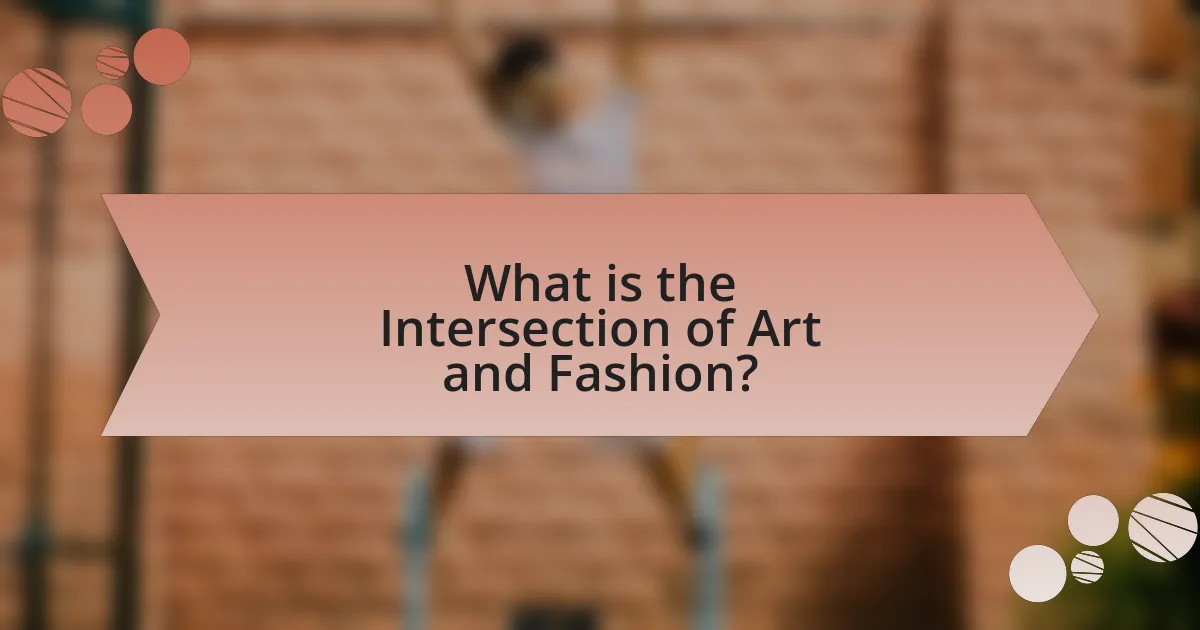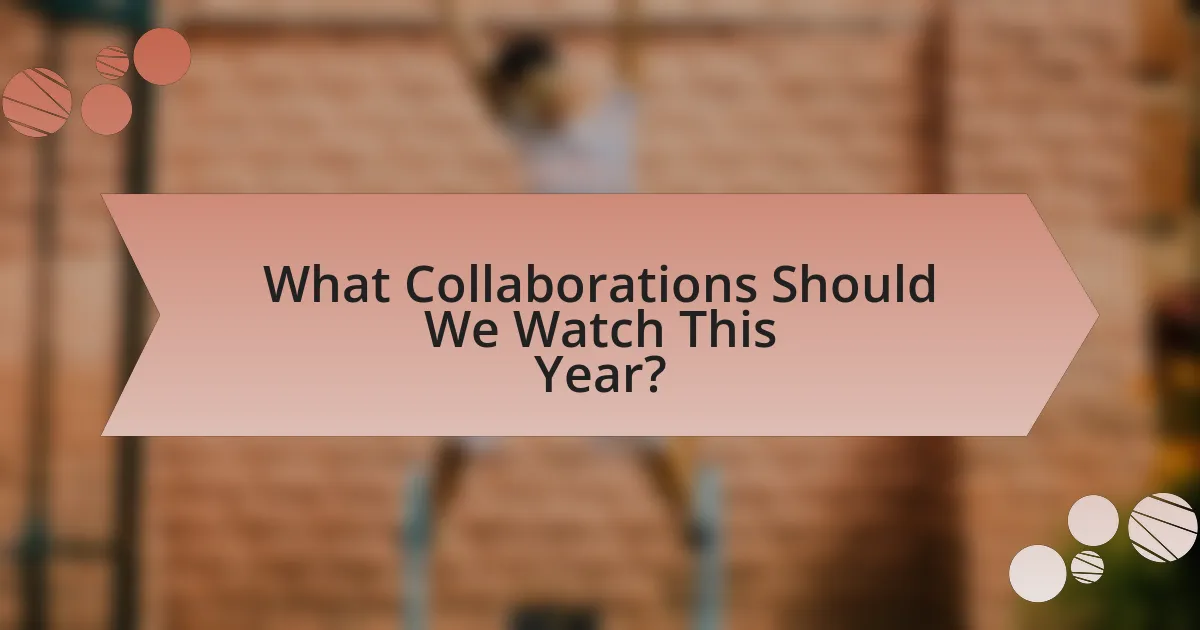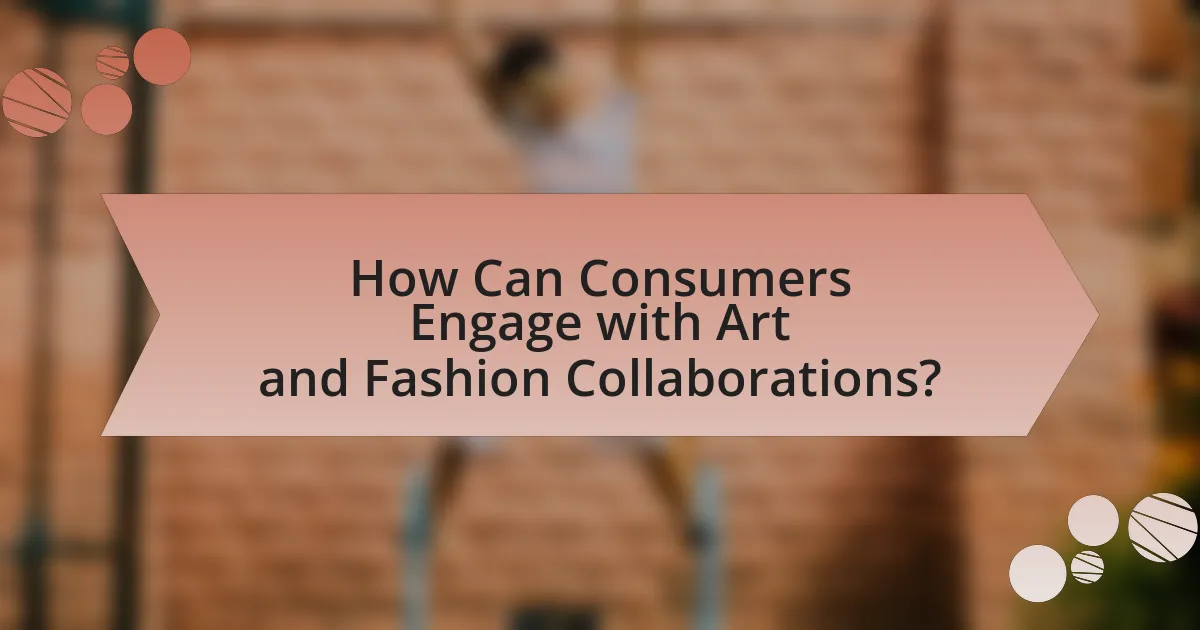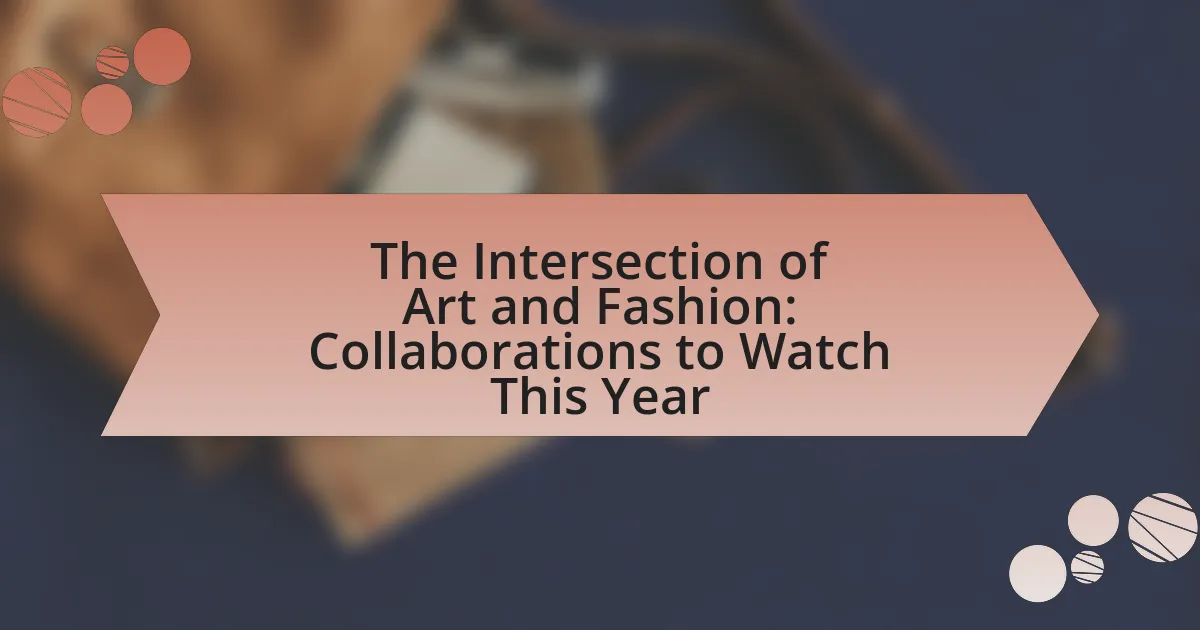The article explores the intersection of art and fashion, highlighting the collaborative relationships that influence both fields. It examines how artistic expression informs fashion design and vice versa, with historical examples such as the partnerships between Andy Warhol and Halston, and Yves Saint Laurent and Piet Mondrian. The piece also discusses contemporary collaborations involving artists like Yayoi Kusama and Takashi Murakami, emphasizing their impact on cultural trends and consumer engagement. Additionally, it outlines anticipated trends for the year, including sustainability and digital integration, while providing insights on how consumers can engage with and support these collaborations.

What is the Intersection of Art and Fashion?
The intersection of art and fashion refers to the collaborative relationship where artistic expression influences fashion design and vice versa. This synergy manifests through various forms, such as fashion designers drawing inspiration from visual art movements, and artists creating wearable art pieces. For instance, the collaboration between fashion designer Alexander McQueen and artist Damien Hirst showcased how fashion can serve as a canvas for artistic ideas, merging aesthetics and functionality. Additionally, exhibitions like “The Fashion World of Jean Paul Gaultier” highlight how fashion can be appreciated as an art form, emphasizing the cultural and historical significance of clothing. This intersection not only enriches both fields but also engages audiences in new and innovative ways.
How do art and fashion influence each other?
Art and fashion influence each other through a dynamic interplay where artistic expression informs design aesthetics and fashion trends inspire artistic themes. For instance, many fashion designers draw inspiration from art movements, such as Yves Saint Laurent’s iconic Mondrian dress, which directly referenced Piet Mondrian’s geometric paintings. Conversely, fashion often serves as a medium for artists, as seen in collaborations like those between contemporary artists and brands, such as Jeff Koons and Louis Vuitton, where art is translated into wearable pieces. This reciprocal relationship not only shapes visual culture but also reflects societal trends, as both domains respond to and critique contemporary issues, thereby enriching each other’s narratives.
What historical examples illustrate this relationship?
Historical examples illustrating the relationship between art and fashion include the collaboration between Andy Warhol and the fashion brand Halston in the 1970s, where Warhol’s pop art aesthetic influenced Halston’s designs, merging high fashion with contemporary art. Another significant example is the partnership between Yves Saint Laurent and artist Piet Mondrian in 1965, which resulted in the iconic Mondrian dress, showcasing how art can directly inspire fashion design. Additionally, the collaboration between Jean-Paul Gaultier and the artist Keith Haring in the 1980s highlighted the intersection of street art and haute couture, demonstrating the impact of urban art on fashion trends. These collaborations not only blurred the lines between the two disciplines but also created lasting cultural moments that continue to influence the fashion industry today.
How have contemporary artists integrated fashion into their work?
Contemporary artists have integrated fashion into their work by collaborating with fashion designers and brands, creating pieces that blur the lines between art and wearable design. For instance, artists like Takashi Murakami and Yayoi Kusama have partnered with luxury brands such as Louis Vuitton to produce collections that feature their distinctive artistic styles on clothing and accessories. These collaborations not only elevate the visibility of the artists’ work but also challenge traditional notions of art by placing it within the context of consumer culture. Additionally, artists like Virgil Abloh have utilized their platforms to merge streetwear aesthetics with high art, further demonstrating the fluidity between these two realms.
Why are collaborations between artists and fashion designers significant?
Collaborations between artists and fashion designers are significant because they fuse creative expressions, resulting in innovative and culturally relevant designs. This synergy allows for the exploration of new aesthetics and concepts, often leading to unique collections that challenge traditional fashion norms. For instance, the collaboration between artist Yayoi Kusama and Louis Vuitton in 2012 introduced polka dots as a signature motif, merging fine art with luxury fashion and expanding the audience for both fields. Such partnerships not only enhance brand visibility but also elevate the cultural discourse surrounding fashion, making it more inclusive and dynamic.
What impact do these collaborations have on cultural trends?
Collaborations between art and fashion significantly shape cultural trends by merging distinct creative expressions and broadening audience engagement. These partnerships often lead to innovative designs that reflect contemporary societal themes, such as sustainability and diversity, influencing consumer preferences and behaviors. For instance, the collaboration between artist Takashi Murakami and Louis Vuitton not only elevated the brand’s aesthetic but also popularized the concept of high art in mainstream fashion, demonstrating how such collaborations can redefine cultural norms and expectations.
How do they challenge traditional boundaries in both fields?
Art and fashion challenge traditional boundaries by merging creative expressions and redefining aesthetic norms. Collaborations between artists and fashion designers often result in innovative collections that blur the lines between wearable art and functional clothing, such as the partnership between Takashi Murakami and Louis Vuitton, which transformed luxury fashion into a canvas for contemporary art. These collaborations not only expand the definition of fashion but also elevate art by making it accessible to a broader audience, thus reshaping cultural perceptions and market dynamics in both fields.

What Collaborations Should We Watch This Year?
This year, notable collaborations to watch include the partnership between Gucci and the artist Yayoi Kusama, which merges high fashion with Kusama’s iconic polka dot patterns. Additionally, the collaboration between Prada and the artist Peter Doig is set to explore the intersection of contemporary art and luxury fashion, showcasing unique designs inspired by Doig’s paintings. These collaborations are significant as they reflect a growing trend where fashion brands increasingly engage with contemporary artists to create limited-edition collections that resonate with both art and fashion enthusiasts.
Which artists are currently collaborating with fashion brands?
Currently, artists such as Billie Eilish, Travis Scott, and Virgil Abloh are collaborating with fashion brands. Billie Eilish has partnered with Nike for a sustainable sneaker line, while Travis Scott has worked with brands like Dior and McDonald’s, creating unique merchandise and apparel. Virgil Abloh, known for his role at Louis Vuitton, has consistently collaborated with various brands, including his own Off-White label, which merges streetwear with high fashion. These collaborations highlight the ongoing trend of artists influencing fashion through innovative designs and cultural relevance.
What unique styles or themes are emerging from these collaborations?
Unique styles emerging from collaborations between art and fashion include a blend of surrealism and streetwear, characterized by bold graphics and unconventional materials. These collaborations often feature artists who infuse their signature aesthetics into fashion pieces, creating wearable art that challenges traditional design norms. For instance, partnerships like that of Takashi Murakami with Louis Vuitton showcase vibrant colors and playful motifs, while the collaboration between Yayoi Kusama and various fashion brands emphasizes polka dots and immersive patterns. Such themes reflect a growing trend where artistic expression transcends galleries, making its way into everyday fashion, thus democratizing art and enhancing cultural dialogue.
How are these collaborations being received by the public and critics?
These collaborations are being received positively by both the public and critics. Many fashion and art enthusiasts express excitement over the innovative designs and unique concepts that emerge from these partnerships. Critics highlight the successful blending of artistic expression with wearable fashion, often noting that these collaborations push creative boundaries and attract diverse audiences. For instance, a recent collaboration between a renowned artist and a luxury fashion brand received high praise in major fashion publications, with critics emphasizing its impact on contemporary culture and consumer engagement.
What are the anticipated trends in art and fashion collaborations for this year?
Anticipated trends in art and fashion collaborations for this year include a focus on sustainability, digital integration, and cultural storytelling. Sustainability is becoming increasingly important, with brands partnering with artists who emphasize eco-friendly practices and materials. Digital integration is also on the rise, as collaborations leverage augmented reality and NFTs to create immersive experiences. Additionally, cultural storytelling is gaining traction, with fashion brands collaborating with artists from diverse backgrounds to reflect and celebrate various cultural narratives. These trends are supported by the growing consumer demand for authenticity and social responsibility in both art and fashion.
How might these trends influence future collaborations?
These trends may lead to more interdisciplinary collaborations between artists and fashion designers, fostering innovative approaches that blend visual art with wearable design. As seen in recent partnerships, such as the collaboration between artist Takashi Murakami and Louis Vuitton, the merging of artistic expression with fashion not only enhances brand visibility but also attracts diverse audiences. This trend indicates a growing demand for unique, culturally rich products, suggesting that future collaborations will increasingly prioritize artistic authenticity and storytelling, ultimately reshaping consumer expectations and market dynamics.
What role does social media play in promoting these collaborations?
Social media plays a crucial role in promoting collaborations between art and fashion by providing a platform for instant visibility and engagement. It allows artists and fashion brands to showcase their partnerships to a global audience, facilitating real-time interaction and feedback. For instance, campaigns launched on platforms like Instagram and TikTok can reach millions of users within hours, significantly amplifying the reach of collaborative projects. According to a 2021 report by Hootsuite, 54% of social media users use these platforms to research products, indicating that social media is a vital tool for driving consumer interest and awareness in these collaborations.

How Can Consumers Engage with Art and Fashion Collaborations?
Consumers can engage with art and fashion collaborations by participating in events, purchasing limited-edition items, and following brands on social media for updates. Events such as gallery openings, fashion shows, and pop-up shops provide opportunities for direct interaction with the artists and designers involved. Purchasing limited-edition items allows consumers to own unique pieces that reflect the collaboration, often enhancing their personal style and supporting the artists. Additionally, following brands on social media platforms enables consumers to stay informed about new releases, behind-the-scenes content, and exclusive offers, fostering a deeper connection to the collaboration.
What are the best ways to support these collaborations?
The best ways to support collaborations between art and fashion include fostering open communication, providing financial backing, and promoting joint marketing efforts. Open communication ensures that both artists and designers align their visions and expectations, which is crucial for a successful partnership. Financial backing can come from grants, sponsorships, or crowdfunding, enabling projects to materialize without financial constraints. Joint marketing efforts, such as co-branded campaigns or events, amplify visibility and reach, attracting a broader audience. These strategies have been shown to enhance collaboration outcomes, as evidenced by successful partnerships like the collaboration between artist Takashi Murakami and Louis Vuitton, which significantly boosted brand engagement and sales.
How can consumers participate in events or exhibitions related to these collaborations?
Consumers can participate in events or exhibitions related to collaborations in art and fashion by attending scheduled shows, workshops, and interactive installations. These events are often promoted through social media, official websites, and newsletters of the collaborating brands or artists, providing details on dates, locations, and ticketing information. For instance, major fashion weeks and art fairs frequently feature collaborative showcases, allowing consumers to engage directly with the work and the creators. Additionally, many exhibitions offer opportunities for consumers to purchase exclusive merchandise or participate in guided tours, enhancing their experience and connection to the collaboration.
What should consumers look for when purchasing collaborative pieces?
Consumers should look for authenticity and quality when purchasing collaborative pieces. Authenticity ensures that the collaboration genuinely reflects the vision and style of both artists or brands involved, which can enhance the value and uniqueness of the item. Quality is crucial as it indicates the craftsmanship and materials used, impacting the longevity and overall satisfaction with the purchase. For instance, collaborations between established artists and reputable fashion brands often result in limited-edition pieces that combine artistic expression with high-quality production standards, making them more desirable to collectors and fashion enthusiasts.
What practical tips can enhance the experience of engaging with art and fashion collaborations?
To enhance the experience of engaging with art and fashion collaborations, actively participate in events such as gallery openings, fashion shows, and workshops that showcase these collaborations. Engaging directly with the artists and designers allows for a deeper understanding of their creative processes and intentions. Additionally, following social media accounts and blogs dedicated to art and fashion can provide insights into upcoming collaborations and trends, fostering a more informed perspective. Research indicates that immersive experiences, such as interactive installations or pop-up events, significantly increase audience engagement and appreciation, as seen in successful collaborations like the partnership between Yayoi Kusama and Louis Vuitton.
